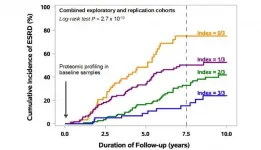(Press-News.org) Individuals who contract COVID-19 even after vaccination are likely to have a lower viral load, experience a shorter infection time and have milder symptoms than people who are unvaccinated, according to research that includes data from ongoing University of Arizona Health Sciences studies.
"If you get vaccinated, about 90% of the time you're not going to get COVID-19," said Jeff Burgess, MD, MS, MPH, associate dean for research and professor at the Mel and Enid Zuckerman College of Public Health and principal investigator of the Arizona Healthcare, Emergency Response, and Other Essential Workers Surveillance (AZ HEROES) study. "Even if you do get it, there will be less of the virus in you and your illness is likely to be much milder."
While the COVID-19 vaccines are proving to be highly effective in preventing COVID-19 infection, no vaccine is 100% effective and breakthrough infections do occur. Among 3,975 participants in two studies, SARS-CoV-2 infections were identified in five participants who were fully vaccinated and 11 who were partially vaccinated, as well as in 156 unvaccinated participants. Approximately half of the participants were from Arizona study sites.
Researchers found that study participants who were partially or fully vaccinated with the Pfizer and Moderna messenger RNA vaccines at the time of infection had a viral load that was 40% less than that of unvaccinated participants. Viral load - the amount of SARS-CoV-2 virus found in a test sample - is not an indicator of how contagious an individual is, though early COVID-19 research suggests viral load could play a role in disease severity and secondary transmission.
In addition to disease severity, researchers looked at infection longevity. The majority of infections among unvaccinated participants were detected for two or more weeks, compared with only one week among vaccinated participants. That represents a 66% reduction in the risk that a vaccinated person will have a confirmed infection for more than one week.
Additionally, the risk of having COVID-19 with an accompanying fever was 58% lower for vaccinated participants, who reported two fewer days sick in bed, on average, and an overall length of illness that was six days shorter than that of unvaccinated people.
The paper, published in the New England Journal of Medicine, incorporates data from two ongoing CDC-funded studies: the AZ HEROES study and the Abt Associates-led Research on the Epidemiology of SARS-CoV-2 in Essential Response Personnel (RECOVER) study. Study participants - health care personnel, first responders, and other essential and frontline workers in eight U.S. locations - continue to undergo weekly nasal swabs to test for COVID-19, as well as quarterly blood tests.
Including data from Dec. 14 to April 10, researchers found that two doses of an mRNA COVID-19 vaccine were 91% effective against infection with SARS-CoV-2, the virus that causes COVID-19. Additionally, the report indicated a single dose of vaccine proved 81% effective against SARS-CoV-2 infection. This is on par with study data published in the U.S. Centers for Disease Control and Prevention's Morbidity and Mortality Weekly Report on March 29.
"We are still seeing the same high levels of vaccine effectiveness, so we feel good about that," Dr. Burgess said. "But more importantly, we've added a number of measures of the severity of infection among individuals who have been vaccinated as a comparison to those who haven't, and we measured how much virus there is and for how long."
In addition to continuing research into COVID-19 immunity and vaccine efficacy, AZ HEROES researchers are beginning to examine the frequency of SARS-CoV-2 variants. The study was originally funded with a $7.7 million CDC grant.
"We recently were awarded another year of funding," said AZ HEROES research team member Karen Lutrick, PhD, assistant professor in the Department of Family and Community Medicine at the College of Medicine - Tucson. "We really appreciate the participation of all of our AZ HEROES and RECOVER participants, because without them and their work, we wouldn't have this information to share."
INFORMATION:
Other members of the AZ HEROES research team include: Janko Nikolich-?ugich, MD, PhD, head of the College of Medicine - Tucson's Department of Immunobiology and co-director of the Center on Aging; and Kate Ellingson, PhD, Joe Gerald, MD, PhD, and Xiaoxiao Sun, PhD, at the Zuckerman College of Public Health.
AZ HEROES is still recruiting participants, including health care workers, first responders, and other frontline and essential workers, such as teachers and food service workers, as well as student workers who have not already been vaccinated. Participants both with and without past COVID-19 infection are welcome to join.
To learn more about the study please visit the AZ HEROES website: https://azheroes.arizona.edu/
MINNEAPOLIS - Finding treatments for advanced multiple sclerosis (MS) has been difficult. But new research may help neurologists identify which drugs are best for people with the advanced form of MS called secondary progressive MS. The new study, published in the June 30, 2021, online issue of Neurology®, the medical journal of the American Academy of Neurology, found that the more potent disease-modifying drugs are more effective in reducing flare-ups in secondary progressive MS than the less potent drugs that tend to be safer to take. However, the researchers found no difference in how fast the disease progressed between these two types of drugs.
Most ...
MINNEAPOLIS - A new study suggests that even when differences in socioeconomic status are taken into consideration, Black people with multiple sclerosis (MS) may be more negatively impacted by the disease than white people with MS. The research is published in the June 30, 2021, online issue of Neurology®, the medical journal of the American Academy of Neurology. The study found that Black people with MS had lower scores on certain measures of neurological health, like dexterity and walking tests and showed more evidence of disease progression on brain scans.
"While lower socioeconomic status appears to be linked to doing worse on tests ...
June 30, 2021 - For most patients, the reasons for having a facelift are simple: to "turn back the clock" for a younger and more attractive appearance. Even during the pandemic year 2020, more than 234,000 patients underwent facelift surgery, according to American Society of Plastic Surgeons (ASPS) statistics.
When considering facelift surgery, patients may ask, "How much younger will I look?" For plastic surgeons, that has been a difficult question to answer. Typically, the cosmetic outcomes of facelifting have been judged on a case-by-case basis, or with the use of subjective ratings.
Now research suggests a new, objective approach to assessing the reduction in apparent age after facelift surgery: artificial intelligence (AI) networks trained to estimate age based on facial ...
Electron motion in atoms and molecules is of fundamental importance to many physical, biological, and chemical processes. Exploring electron dynamics within atoms and molecules is essential for understanding and manipulating these phenomena. Pump-probe spectroscopy is the conventional technique. The 1999 Nobel Prize in Chemistry provides a well-known example wherein femtosecond pumped laser pulses served to probe the atomic motion involved in chemical reactions. However, because the timescale of electron motion within atoms and molecules is on the order of attoseconds (10-18 seconds) rather than femtoseconds (10-15 seconds), attosecond pulses are required to probe electron motion. With the development of ...
A recent University of Arizona College of Pharmacy study suggests that Objective Structured Clinical Examinations (OSCEs) may be a valuable means of assesing clinical skills while providing learning experiences for pharmacy students in community pharmacy settings. While the OSCEs were designed to assess health care professionals in a clinical setting, there was limited data on its use in testing skills required in community pharmacies, until now.
For pharmacists working in retail, guiding patients on the use of over-the-counter (OTC) drugs is a common part of the job. According to a recent survey from the American ...
Directing a meeting, dialing up an old acquaintance, dictating the perfect tuna salad sandwich across a drive-through window. For business and for pleasure, human beings are in constant communication.Our proclivity for socialization is lifelong, equally prominent in the lives of adolescents and adults. A recent study determined key differences in the ways that various age groups communicate, as well as one conversational component that stands the test of time: friendship. Specifically, bonds between individuals who identify as female.
Led by former Beckman Institute postdoctoral researchers Michelle Rodrigues and Si On Yoon, an interdisciplinary team evaluated how interlocutors' age and familiarity with one another impacts a conversation, reviewing the interaction's ...
Elevated levels of three specific circulating proteins are associated with protection against kidney failure in diabetes, according to research from the Joslin Diabetes Center that will be published 30th June in Science Translational Medicine.
"As well as acting as biomarkers for advancing kidney disease risk in diabetes, the proteins may also serve as the basis for future therapies against progression to the most serious types of kidney disease," said Andrzej S. Krolewski MD, PhD, senior author on the publication, senior investigator at Joslin Diabetes Center and professor of medicine ...
A 7- to 15-year longitudinal study of 358 diabetics has linked 3 proteins in blood with a slower progression of diabetic kidney disease and progressive kidney failure. The results from Zaipul Md Dom and colleagues suggest that the proteins could help researchers identify diabetics most at risk of kidney damage, potentially enabling earlier interventions and treatment. Despite advancements in blood sugar control and kidney therapies, patients with type 1 or type 2 diabetes still face a high risk of diabetic kidney disease. This condition can eventually progress to end-stage kidney disease, but some patients show slower kidney decline than others. In recent ...
Despite unprecedented advancements in technology and countless depictions of complex human-AI interactions in sci-fi movies, we have yet to fully achieve AI bots that can engage in conversation as naturally as humans can. Kushal Chawla, researcher at the USC Institute for Creative Technologies (ICT) and a doctoral student in computer science, along with collaborators at both the USC Information Sciences Institute (ISI) and ICT are taking us one step closer to this reality by teaching AI how to negotiate with humans.
The research, presented at the 2021 Annual Conference of ...
Although cardiovascular disease is the main cause of illness among women in the U.S., certain conditions such as coronary microvascular disease (CMD) cannot be easily diagnosed. In a new study, researchers at the University of Illinois Urbana-Champaign have identified specific biomarkers for CMD, which might reduce future hospitalizations.
CMD damages the inner walls of blood vessels causing spasms and decreased blood flow to the heart muscle. "Clinicians look for plaque formation in the blood vessels, which does not occur in CMD," said Zeynep Madak-Erdogan (CGD/EIRH/GSP), an associate professor of nutrition. "Usually, ...



